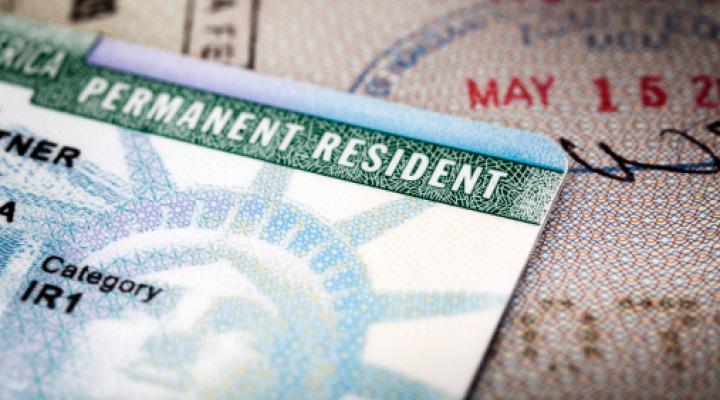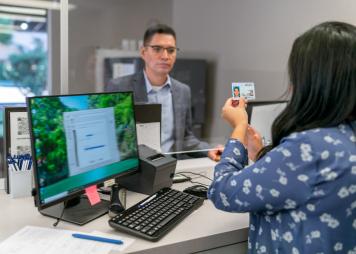Conseguir la tarjeta de residente permanente

Lawful permanent residents (LPRs), also known as “green card” holders, are non-citizens who are lawfully authorized to live permanently within the United States. LPRs may accept an offer of employment without special restrictions, own property, receive financial assistance at public colleges and universities, and join the Armed Forces. They also may apply to become U.S. citizens if they meet certain eligibility requirements.
El proceso y los requisitos pueden variar en función de si el inmigrante ya vive dentro o fuera de Estados Unidos. Lea esta guía para comprender mejor cómo conseguir la tarjeta de residente permanente.
Steps for Getting a Green Card
Determine your eligibility: To be eligible for a green card, an immigrant must fall into one of the categories established by U.S. immigration law. These categories include family members of U.S. citizens or permanent residents, workers, refugees and asylum seekers, and diversity lottery winners.
Submit the appropriate application form: After determining eligibility, the immigrant must submit the appropriate application form. Form I-485 is the application for those already living in the U.S., while Form DS-260 is used for those living outside the U.S.
Collect supporting documents: The applicant must also provide supporting documents to prove eligibility. These documents may include a birth certificate, passport, marriage certificate, employment offer letter, or other evidence. The documents required for a green card application vary depending on the category you are applying under. In general, applicants will need to submit a completed Form I-485, Application to Register Permanent Residence or Adjust Status, along with supporting documents such as your passport, birth certificate, marriage certificate (if applicable), employment authorization documents (if applicable), and any other required documents.
Attend biometric appointment: After submitting the application, the applicant must attend a biometric appointment where their fingerprints, photograph, and signature are taken.
Attend an interview: The applicant may be required to attend an interview with a U.S. immigration officer to discuss their application and eligibility.
Wait for approval: After submitting the application and attending any necessary appointments, the applicant must wait for their green card to be approved. This process can take several months or even years, depending on the applicant's situation and the current USCIS processing times.
Types of Categories for Green Cards
Family-based green card: The sponsor must file a Form I-130 with USCIS and wait for its approval. Once approved, the case is forwarded to the National Visa Center (NVC) for processing. The immigrant must complete a Form DS-260, Online Immigrant Visa and Alien Registration Application, and submit supporting documents. The NVC will schedule a visa interview at a U.S. embassy or consulate in the immigrant's home country. If approved, the immigrant can enter the U.S. as a permanent resident. The process can take several months to several years depending on the visa category and the availability of visa numbers. The cost is currently $325 for the I-130 petition plus $345 for the DS-260 application and $220 for the visa processing fee.
Employment-based green card: The immigrant must have a job offer from a U.S. employer who is willing to sponsor them. The employer must obtain a labor certification from the Department of Labor to show that there are no qualified U.S. workers available for the job. The employer must then file a Form I-140, Petition for Alien Worker, with USCIS. The immigrant must also file a Form I-485 and attend a biometrics appointment and an interview. The process can take several months to several years depending on the employment category and the priority date. The cost is currently $1,225 for the I-485 application (including biometrics fee) plus $700 for the I-140 petition.
Refugee or asylee green card: The applicant must have been granted refugee or asylee status by USCIS or the Immigration Court. The immigrant can apply for a green card one year after being admitted as a refugee or one year after being granted asylum. The applicant must file a Form I-485 and attend a biometrics appointment and an interview. There is no fee for the I-485 application. If the immigrant is outside of the U.S., they can apply for a green card through consular processing.
What to Expect When Applying for a Green Card
Processing time: The processing time for a green card application can vary widely depending on several factors, including the category you are applying under and the backlog of applications at the time of your application. In general, it can take several months to several years to receive a decision on your application. Be prepared to wait and have plans to manage the waiting period.
Cost: The cost of a green card application varies depending on the category you are applying under and other factors. For example, the fee for the Form I-485 is currently $1,140, and there may be additional fees for other forms or services, such as legal fees, obtaining documents, translations, or mailing items.
Ineligibility: Some people may not be eligible for a green card, such as those with certain criminal convictions, those who have violated immigration laws, or those who pose a security risk. It's important to consult with an immigration lawyer if you are unsure about your eligibility before starting an application process.
Overall, the process of obtaining a green card can be complex and requires careful attention to detail. It's important to work with an experienced immigration lawyer to ensure that you understand the process and are submitting the required documents correctly.
The information provided on www.onepercentforamerica.org is intended for general informational purposes only. No debe tomarse como asesoramiento profesional ni reemplazar la orientación de un profesional.



